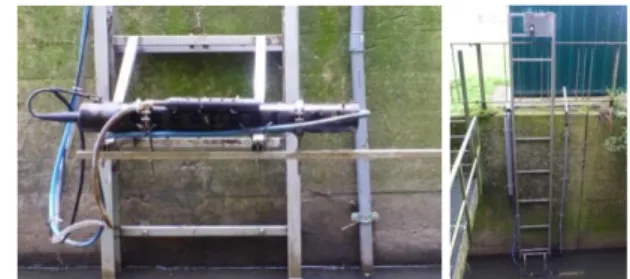Suspended sediment and contaminant transport monitoring in navigable
and unnavigable waterways (Wallonia, Belgium)
Anne-Cécile Denis
1,2, Christophe Frippiat
1, Jean Van Campenhout
2, Geoffrey Houbrechts
2, Didier
Bousmar
3, Eric Hallot
2, Mathieu Veschkens
1, François Petit
2.
1
Institut scientifique de service public, 200 Rue du Chéra, 4000 Liège, Belgium
2
University of Liège, Dep. of Geography, Laboratory of Hydrography and Fluvial Geomorphology, 2 Allée du 6 Août, 4000 Liège, Belgium
3
Service Public de Wallonie, Hydraulic Research Laboratory, 164 Rue de l’Abattoir, 6200 Châtelet, Belgium
Phone: +32-(0)-4 229 82 60 E-mail:ac.denis@issep.be
Introduction: In Wallonia (Belgium), the amount of
suspended sediment accumulated in waterways is estimated at about 527.10³ m³ per year. At least 20% of this volume has to be removed in order to maintain navigation capacity. This maintenance is currently exclusively managed in a curative way: when local sediment accumulations are detected, bathymetric surveys are conducted in order to quantify the volume of sediment to be removed, and chemical analyses of samples allow the characterization of sediment quality. Hence, collected data only allow for a short-term management of the matter generated by dredging operations. Medium or long term planning of dredging operations is currently not possible, due to a lack of knowledge on sediment fluxes and associated pollutant transport. The cost of annual maintenance of waterways is currently estimated at least between 34 and 39 million euros. At present, there is no available data to anticipate the evolution of deposits of sediment or to measure the degree of pollution in recent sediments and thus to improve the sector of sediment management. The aim of this project is to contribute to the development of operational tools allowing the assessment of suspended sediments quality in waterways and non-navigable rivers. In the long term, this study should contribute to the establishment of a control network of suspended sediments quality in Walloon waterways.
Methods: The methodology developed in the project
requires suspended sediments and pollutant transport monitoring at experimental stations (Fig.1), installed in a permanent way, on waterways and their tributaries. In order to quantify suspended sediment transport, the stations are equipped with a sensor that continuously measures turbidity, and an automatic sampler that collects water samples. Sample collection is triggered based on river discharge, so as to target flood events. To characterize the pollutants associated with suspended sediment at the stations, prototypes of Sediment traps and Time Integrated Samplers (TIS) have been developed based on the
prototypes proposed by Tessier [1] and Phillips et al. [2], and installed at the monitoring stations.
Two stations were installed on a waterway, the Sambre River, upstream and downstream of the urban area of Charleroi. A third station has been installed on an unnavigable tributary, the Samme River, which flows into the Charleroi-Brussels canal.
Fig. 1: Automatic sampling station of Ronquières. Results and discussion: Data collected from the
automatic samplers allowed to establish a first relationship between suspended load and water discharge at each station. Sediment budgets were then evaluated based on these relationships. The measurement of the turbidity allowed an improved assessment of the variations of suspended load over time, in particular during flood events. The prototypes of traps and TIS allowed taking enough suspended matter during a short period of time (about 15 days) to characterize pollutants within the sedimentary matrix. According to first analysis, the samples collected are representative of those collected by the automatic sampler (particle size distribution). The analyses of the samples collected by the traps should allow the characterization of the transport of pollutants associated with recent sediments.
Acknowledgements: The authors thank L. Haouche,
R. Detaille and A. Joris.
References: [1] Tessier L. (2003) Thèse doctorale,
Ecole Nationale des Ponts et Chaussées, Paris, 344p [2] Phillips J.M. et al. (2000) Hydrological Processes 2000; 14: 2589-2602.
